| Title | Pages |
|---|---|
| Combined Experimental and Molecular Simulation Study on The Hydrogen Storage Properties of Cu(II) and Ni(II) Metal- Organic Compounds For the purpose of investigating alternative adsorbents, new metal-organic compounds were synthesized, characterized and examined for their hydrogen storage capabilities. First, the compounds were synthesized and then the molecular structures of the compounds were determined experimentally by using thermal, FT-IR, solid-UV and powder-XRD analysis. Then, the crystal structures were solved using theoretical calculations. At last, the simulated maximum hydrogen storage capacities of the compounds were 3.62 and 0.64 wt. % at 77 K and 100 bars, while the numbers less than 0.1 wt. % for 1 bar and same temperature. In brief, crystal structu- res of inorganic compounds are determined with combined experimental and computational techniques, then, hydrogen storage abilities are investigated 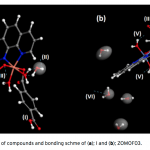

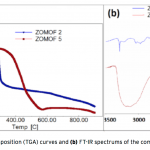
|
1 - 8 |
| Determination and Comparison of Nosema apis and Nosema ceranae in Terms of Geographic and Climatic Factors Nosema species (Nosema apis and Nosema ceranae) are parasitic living beings that causing adult honey bee diseases called Nosemosis and honey bee colonies are often infected with Nosema species. Nosema species should be identified individually and should be compared with climatic and geographic factors in apiaries because of the requirements of different conditions. The aim of this study is screen Nosema species in the apiaries that have different climatic and geographic factors and compare the incidence of Nosema species according to these factors. With the fieldworks conducted within this study, 30 adult bees from each of 169 apiaries were collected and were studied in the laboratory for the detection of Nosema species. The incidence of Nosema species according to environmental and climatic structure of the apiaries were compared statisti- cally. The difference among the selected provinces was found statistically significant in terms of Nosema infection levels by using one-way ANOVA test. At the result of this study, the determination of more Nosema ceranae infected colonies demons- trates that Nosema ceranae’s spread increased in honey bees and it began to take the place of Nosema apis. It was observed that the temperature and humidity values of the apiaries directly affect the Nosema spore density. The Pearson correlation’s tests showed that the increase of these two factors increase Nosema ceranae incidence while the decrease of these two fac- tors increase Nosema apis incidence. Therefore, it was observed that geographic and climatic differences affect the Nosema species and their infection levels. 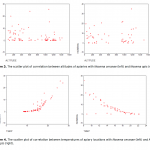
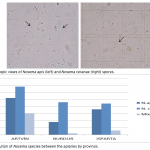
|
9 - 15 |
| Study on Thermophysical Properties of Arginine and Glutamic Acid in Water Using Ab Initio Methods Gibbs free energy and acidic dissociation constants are two important thermodynamic properties of mo- lecules. A combination of ab initio with the density functional theory (DFT) and the polarized continuum model (PCM) of Tomasi’s method were utilized to calculate the acidic dissociation constants of arginine and glutamic acid in water. We applied the basis set at the B3LYP/6-31+G(d) level of theory for accurate theoretical predictions of pKa values. Furthermore, we have evaluated the molecular conformations and solute-solvent interactions of these molecules by the electronic structure theory (commonly DFT method). It was found that in alkaline aqueous solutions the cation, anion, and neutral species of arginine and glutamic acid are solvated with one, two, three, and four molecules of water, respectively. There are intermolecular hydrogen bonds bet- ween the existent species and water molecules. The atomic charges were investigated to analyze the reaction mechanism. In this study, it can be seen that there is a good correlation between experimental attained pKa values and the theoretical computed pKa values. 
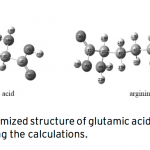
|
17 - 32 |
| Semen quality in 24693 Turkish men over a 16 year period (1995-2011) Studies reporting the sperm count as well as the sperm morphology and quality of Turkish men are limited with case reports and they do not build up a general consensus on this matter. Because of this reason, we evaluated any possible changes in semen quality parameters of Turkish normospermic men during the past 16 years. This is a retrospective study of 24693 men with semen data between 1995 and 2011. Semen quality was evaluated by individual and age dependent (age groups: 18-25, 26-30, 31-35, 36-40, 41-50) statistical analysis of semen volume, sperm concentration, total sperm count and motility. Considering all age groups, mean sperm concentration was found to be 73.2x106/mL. We also demonstrated that mean semen volume of Turkish men is 3.93 ±1.93 mL. C (+2) motility parameter significantly decreased in all age groups. Considering the high number of cases included and the duration studied, the present study is first in reporting Turkish men semen quality. 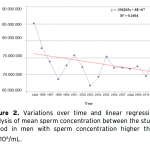
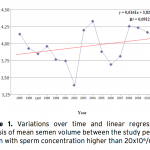
|
33 - 41 |
| Investigation of Biofilm Formation in Clinically Acquired Escherichia coli Strains In this study, investigation of biofilm formation levels of clinically acquired Escherichia coli strains and exami- nation of each E. coli strains’ clinical information such as clinical material and service units according to their biofilm formation results were determined. In this respect, according to our results; E. coli strains are grouped as 31% Strong Biofilm Former (SBF), 27% Intermediate Biofilm Former (IBF), 25 % Weak Biofilm Former (WBF) and 17% None Biofilm Former (NBF). In addition to this, clinical materials of wound and urine were found as the most frequent clinical materials from which strong biofilm Former E. coli strains isolated. Besides, urology and cardiology were found as the most SBF isolated service units. Apart from these, E. coli strains were mostly isolated from urinary tract infections and from women who are at the period of post-menopausal. Lastly, the antibiotic susceptibility patterns were investigated and the greatest susceptibility was observed against amika- cin and the least susceptibility was observed against trimethoprim/sulfamethoxazole. Accordingly, NBF strains of E. coli were more susceptible to eight antibiotics than Strong Biofilm Former (SBF) strains. 

|
43 - 48 |
| Chemical Classification of Propolis Samples Collected from Different Regions of Turkey in Geographical Region Base This study aims to determine chemical compounds of the propolis samples gathered from different regions of Turkey in geographical region-base. Gas Chromatography-Mass Spectrometry (GC-MS) analysis, was per- formed on 21 propolis samples acquired from different geographical regions of Turkey. Samples were collected from five different geographical regions including Black Sea, Central Anatolia, East Anatolia, Marmarean and Mediterranean Regions (Three different phytogeographic regions: European-Sibaerian, Irano-Turanian and Meditteranean phytogeographic regions). So, by this study the chemical compositions of different propolis samples gathered from three distinct phytogeographical regions will be compared. Accordingly, “1-Nona- decene”, “pinocembrin”, “phenylethyl alcohol”, “2-propen-1-one,1-(2,6-dihydroxy-4-methoxy phenyl)-3-phenyl” and particularly “ 2-methoxy-4-vinyl phenol”, “ethyl oleate” were determined as mostly found compounds in collected propolis samples. According to the GC-MS analysis results, five geographical regions are distin- guished from each other according to chemical compound groups. “Benzoic acid “and “17-Pentatriacontene” were found as possible markers of Black Sea Region, “chrysin” for Marmarean region, “2-buten-1-ol,2-methyl”, “Z-12-pentacosane”, “1-Hexacosane” for Central Anatolia, “Nonadecane”, ”Octadecane”, and “2-Nonadecan- one” for East Anatolia Regions. Besides these for the chemical compositions of Mediterranean Region samples, no clear distinction could be found. 

|
49 - 57 |
| Determination of Resistance in Pseudomonas aeruginosa Strains Against Beta-Lactam, Aminoglycoside and Ciprofloxacin Group Antibiotics Nowadays, due to widespread use of broad range spectrum antibiotics in treatments, Pseudomonas aerugi- nosa developed high levels of resistance to these antibiotics. Therefore it is challenging to treat the infec- tions caused by P. aeruginosa. In this study, multi-drug resistant strains and antibiotype groups were identified by investigating resistance in P. aeruginosa strains isolated from three different hospitals in Ankara, against beta-lactam, aminoglycoside and ciprofloxacin. Thus, it was aimed that the most effective antibiotics for treat- ment of P. aeruginosa sourced infections were determined. Sixty-nine P. aeruginosa strains were investigated for resistance against aztreonam, meropenem, imipenem, amikacin, tobramycin, piperacillin, ceftazidime, ce- fepime and ciprofloxacin. It was found that the highest resistance rate was against aztreonam (66.6%) and the most effective antibiotic was found to be amikacin (5.7%). Additionally, the rate of multi-drug resistance in P. aeruginosa strains was determined as 36%. Although, 18 antibiotype groups were identified in P. aeruginosa strains, the highest antibiotype rate was observed in antibiotype 8 which was intermediate to aztronem and sensitive to other 8 antibiotics. In this respect, the combined treatment of aminoglycoside and ciprofloxacin is thought to be effective against resistant P.aeruginosa strains. 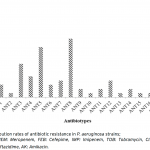
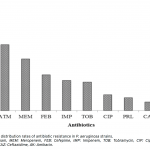
|
59 - 67 |
| New Puccinia (Pucciniales, Basidiomycota) records for Turkey Three rust fungi species, Puccinia pulsatillae Kalchbr. on Pulsatilla violacea Rupr. subsp. armena (Boiss.) Lufe- rov, Puccinia tulipae Schröt. on Tulipa armena Boiss. var. armena and Puccinia coaetanea Bubák on Asperula stricta Boiss. subsp. latibracteata (Boiss.) Ehrend, are reported for the first time from Malatya province in Turkey. The morphological and microscopical features of these fungi are described with figures. 
|
69 - 72 |